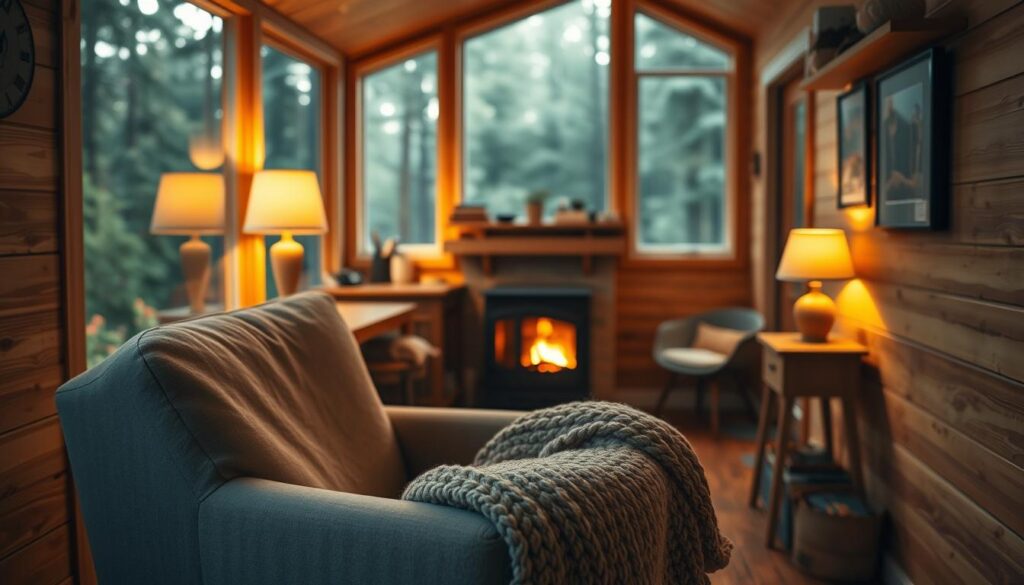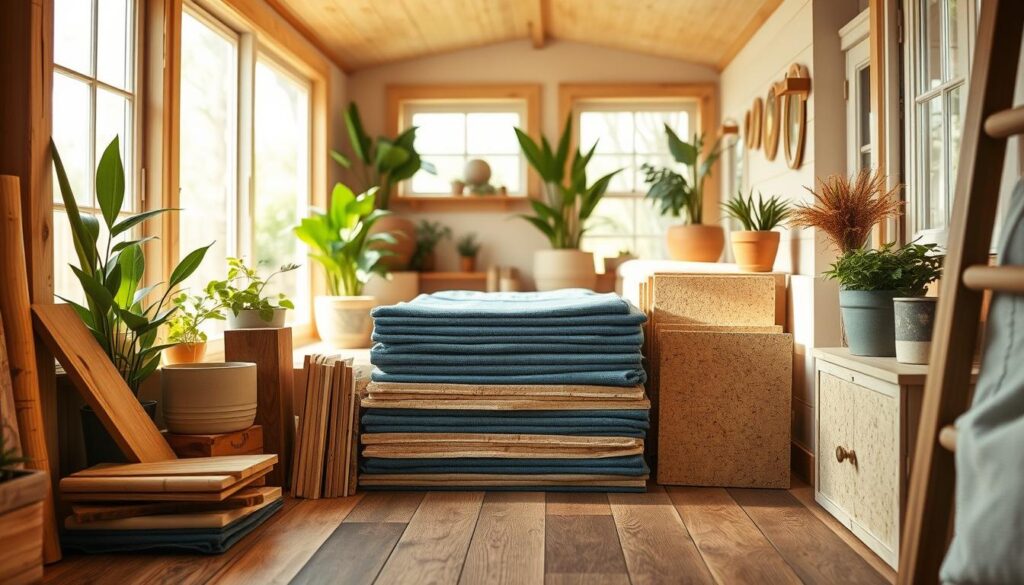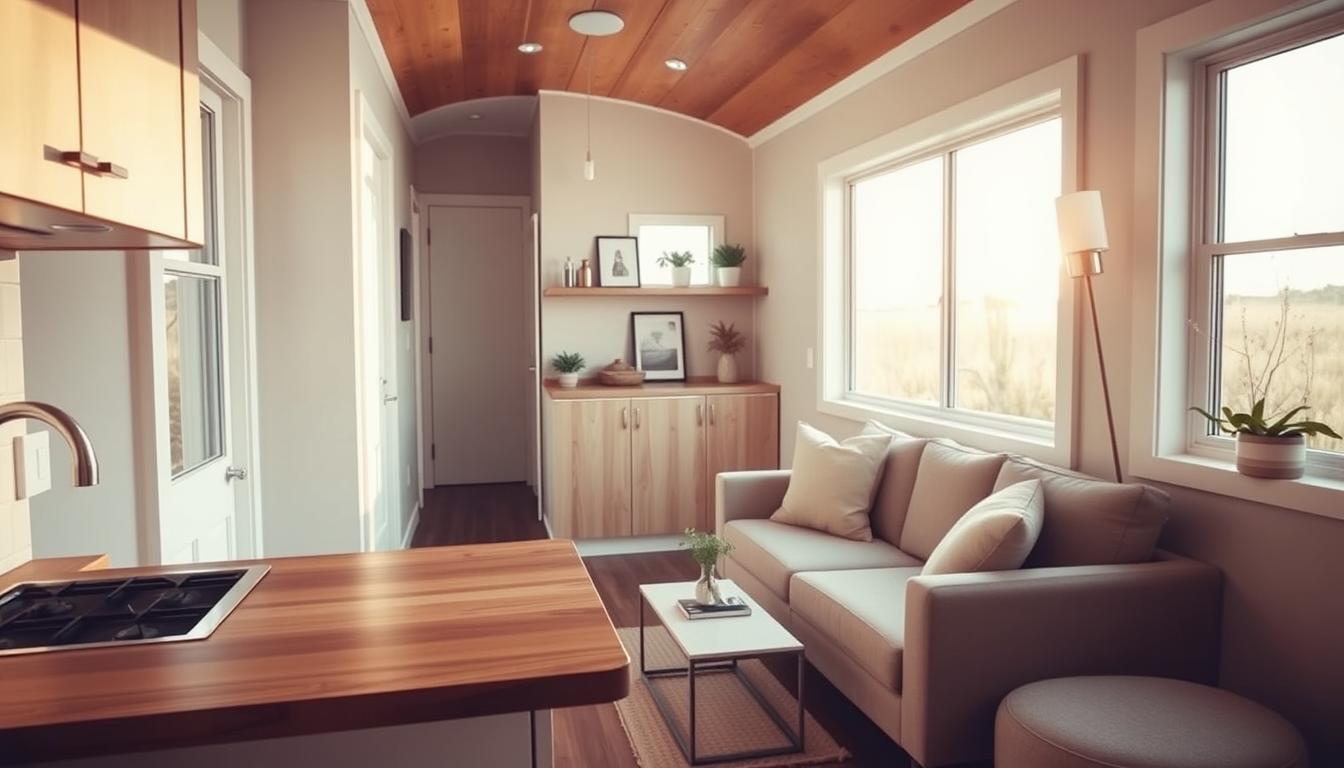Did you know the average tiny home is about 225 square feet? This small space needs careful planning to be both functional and cozy. Exploring small space design shows how important the interior design is.
We’ll show you how to make your tiny home cozy and inviting. We’ll cover planning your layout, picking the right furniture, and choosing decor. You’ll get practical tips and inspiration along the way.
Key Takeaways
- Optimize your layout for maximum space efficiency
- Choose multi-functional furniture for versatility
- Utilize vertical space for storage and decor
- Select a color scheme that enhances the sense of space
- Incorporate natural light to brighten up your space
Understanding the Essentials of Tiny Home Living
Living in a tiny home means understanding its core principles. It’s not just about having less space. It’s about improving our life quality.
The Benefits of Downsizing
Downsizing to a tiny home is freeing. It makes us focus on what’s essential. We get rid of clutter and use space-saving furniture that does more than one thing.
Downsizing has many benefits. For example, it lowers utility bills and maintenance costs. This frees up money for other things. Plus, it promotes a greener lifestyle, fitting well with minimalistic living.
| Benefits | Description |
|---|---|
| Financial Savings | Lower utility bills and reduced maintenance costs. |
| Sustainable Living | Smaller carbon footprint and reduced waste. |
| Simplified Lifestyle | Less clutter, more focus on what’s important. |
Key Design Principles for Tiny Spaces
Designing tiny home interiors involves key principles. For more ideas on cozy and stylish tiny home interiors, check out our guide on tiny home interiors.
Good design in tiny homes uses space-saving furniture and smart storage. Choosing furniture that does more than one thing helps us use space well without losing comfort or style.
- Using light colors to create a sense of depth and openness.
- Incorporating mirrors to create the illusion of more space.
- Selecting furniture that is proportionate to the size of the room.
By following these principles, we can make a space that’s both functional and beautiful. It meets our needs and shows our personal style.
Planning Your Tiny Home Layout
The layout of your tiny home is key to a cozy and functional space. A well-thought-out layout can greatly enhance your home’s comfort and charm.
Zoning Spaces for Functionality
Zoning your tiny home into different areas is vital for tiny home organization. This approach boosts your space’s functionality. Think about these zones:
- Living Area: Set up a spot for relaxation and fun.
- Cooking Zone: Use compact appliances and smart storage in your kitchen.
- Sleeping Quarters: Make a cozy bedroom with enough room for clothes and personal items.
- Workspace: If you need one, create a small area for work or study.
Defining these zones can make your tiny home feel bigger and more organized.
Open Floor Plans vs. Defined Areas
The debate on tiny home layouts centers on open floor plans versus defined areas. Open floor plans can make your home feel larger by removing walls. This creates a continuous space. Yet, defined areas offer privacy and separation for different activities.
Your choice depends on what you like and how you live. Some like the openness of a single room. Others prefer the privacy of separate areas.
Try a mix of both. For instance, have an open living area but keep the bedroom and bathroom private. This way, you get the best of both worlds in tiny house décor and function.
Choosing the Right Color Palette
The right color palette can make your tiny home feel bigger and more welcoming. It’s key to pick colors that enhance the space’s feel.
Light Colors to Create Depth
Light colors on walls and ceilings can make a tiny home look bigger. Light colors reflect light, making the area feel open and airy. This trick works well in small rooms, where dark colors can feel too tight.
Popular light colors include soft whites, creamy beiges, and pale grays. These colors make the space feel larger and provide a clean background for furniture and decor.
Accent Colors for Personality
Light colors create space, but accent colors add personality. Accent colors can be used sparingly through furniture, rugs, and decor to add a pop of color and interest.
Think about the look you want when picking accent colors. Warm tones like terracotta or golden brown can make a cozy feel. For a modern vibe, bold colors like navy blue or emerald green can stand out against light backgrounds.
| Color Scheme | Description | Effect on Tiny Home |
|---|---|---|
| Monochromatic Light | Using different shades of a single light color | Creates a cohesive, spacious feel |
| Complementary Accents | Pairing light colors with bold, contrasting accents | Adds visual interest and personality |
| Analogous Colors | Using colors that are next to each other on the color wheel | Creates a harmonious, soothing atmosphere |
By choosing a color palette that balances light and accent colors, you can make your tiny home cozy and inviting. It will feel spacious and personal.
Selecting Multi-Functional Furniture
The right multi-functional furniture can turn a tiny home into a cozy and efficient space. Choosing furniture that does more than one thing is key. It helps make the most of your space and comfort.
When designing a tiny home, picking space-saving furniture is crucial. It should be stylish and functional. Look for pieces that can change or be used in different ways.
Foldable and Expandable Solutions
Foldable and expandable furniture is great for tiny homes. It lets you change your space as you need. For example, a foldable dining table saves space when not in use.
Expandable furniture, like sofas or beds, adds function without taking up too much space. This way, you get more without losing room.
- Foldable chairs and tables for easy storage
- Expandable sofas for additional seating
- Murphy beds for maximizing floor space
Innovative Storage Solutions
Tiny house storage solutions are essential for keeping things tidy. Use wall space with shelves, units, and cabinets. This boosts your storage. Furniture with built-in storage, like ottomans or beds, also helps hide things.
For more ideas on tiny home interiors, see our tips on beautiful tiny home interiors.
By using these strategies and picking the right furniture, you can make a tiny home that’s both useful and looks great.
Maximizing Natural Light in Tiny Homes
Designing a tiny home means making sure it gets lots of natural light. This light makes your home feel bigger and more inviting. We’ll look at how to use windows and mirrors to get more light.
Window Placement Strategies
Where you put your windows is very important. Place them where they get the most sun. This might mean big windows or more on the sunny side.
Here’s a table to help with window placement:
| Window Placement | Benefits |
|---|---|
| South-facing windows | Get the most sunlight all day |
| East-facing windows | Catch morning sun |
| West-facing windows | Enjoy afternoon sun |
Incorporating Mirrors for Illusion
Mirrors can also make your home look bigger. Put them opposite windows to bounce light around. This makes your home feel larger.
Tips for using mirrors effectively:
- Put a mirror opposite a window to reflect light.
- Use a big mirror to make a room seem bigger.
- Think about mirrored furniture or decor for more light.
With these tips, your tiny home will be brighter and feel bigger than it is.
Creating a Cozy Atmosphere
A cozy tiny home is more than looks; it’s a warm, inviting space. We focus on adding warmth and character to our tiny homes.
Textiles and Soft Furnishings
Textiles are key to a cozy feel. We use plush rugs, soft blankets, and comfortable upholstery for warmth and texture. It’s important to pick materials that are comfy and look good too.
A thick, plush area rug can set off a tiny home’s living area. Velvet pillows and chunky throw blankets make a simple sofa cozy. We choose colors that match our décor for a harmonious look.

Layering Lighting Solutions
Lighting is vital for a cozy feel. We mix overhead lighting, table lamps, and floor lamps for a warm glow.
Dimmable overhead lights light up the room, while soft glow table lamps warm up reading spots. String lights or fairy lights add a magical touch in the evenings.
With these touches, our tiny homes become cozy and relaxing, feeling like our own homes.
Personalizing Your Tiny Home Interior
Tiny homes are a blank canvas for your style. They offer a chance to make your home truly yours. Personal touches make it feel like home.
Incorporating Artwork and Decor
Art and decor are crucial for personalizing your tiny home. They bring life and warmth to your space. Choose items that fit your furniture and style.
Tips for Choosing Artwork:
- Choose pieces that speak to you.
- Match the colors of your interior.
- Mix styles for a unique look.
Decorative items like vases or sculptures add a personal touch. Balance function with beauty.
Plants for Freshness and Air Quality
Plants make your tiny home look better and breathe better. They clean the air and add freshness. This is a win-win for your home.
Benefits of Having Plants:
- They purify the air.
- Plants can lift your mood and reduce stress.
- They bring nature indoors.
For easy care, pick succulents or air plants. They do well indoors and need little attention.
Sustainable Design Practices
As we aim for a greener future, making our tiny homes eco-friendly is key. We’re always looking for ways to lessen our impact on the environment. Our tiny homes are no exception.
By choosing sustainable design practices, we can make homes that are both small and green. This means picking the right materials and using energy wisely.
Using Eco-Friendly Materials
Choosing eco-friendly materials is a big part of sustainable design. This includes recycled, recyclable, or sustainably sourced items. For example, using reclaimed wood can add charm and cut down on waste. For tiny house storage solutions, bamboo or sustainably harvested wood are great choices.
Using eco-friendly materials in your tiny home is good for the planet and for your health. For instance, paints and finishes with low VOCs can improve air quality inside.

Energy Efficiency in Tiny Homes
Energy efficiency is vital in sustainable design. Tiny homes are naturally more energy-efficient than big ones. But, we can still make them better. This can be done with energy-saving appliances, good insulation, and smart window placement.
When designing your tiny home, think about space-saving furniture that’s also energy-efficient. A sofa bed with storage, for example, saves space and energy.
Adding renewable energy sources, like solar panels, can also help. It makes your tiny home even more eco-friendly.
By focusing on sustainable design, we can build tiny homes that are not just pretty and useful but also green. It’s about making choices that help us and the planet.
Tips for Organizing and Decluttering
In tiny homes, keeping things organized is essential. It helps you make the most of your space and feel less stressed. Good organization makes your home more useful and improves your life.
Smart Storage Solutions
Smart storage is vital in tiny homes. Look for multi-functional furniture that also stores things. For example, ottomans or beds with drawers underneath.
- Use wall-mounted shelves or storage units to save floor space.
- Choose furniture that does more than one thing.
- Buy stackable containers and bins for storing items.
For example, a storage ottoman can be a place to sit and also hold things like linens. Adjustable shelves can fit items of different sizes.
Regular Maintenance Strategies
Keeping your tiny home tidy needs regular upkeep. Set aside time for decluttering and take care of your storage.
| Maintenance Task | Frequency | Benefits |
|---|---|---|
| Decluttering | Weekly | Reduces stress and saves time |
| Organizing Storage | Monthly | Enhances functionality and accessibility |
| Deep Cleaning | Quarterly | Maintains hygiene and overall health |
By following these tips, you can have a tidy, stress-free tiny home. Regular upkeep keeps your space clean and supports a green lifestyle.
Case Studies of Inspiring Tiny Home Interiors
Looking at successful tiny home designs can spark your creativity. We’ve collected real-life examples. They show how to make a tiny home both cozy and stylish.
Effective Design Strategies
These case studies highlight the power of planning and creativity. They show how to make a tiny home both useful and lovely. From smart furniture to clever storage, we see how design elements work together.
Lessons from Tiny Home Owners
Tiny home owners share their wisdom. They give tips on keeping a tiny home cozy and space-efficient. Their experiences prove that tiny homes can be both chic and practical.
By studying these examples, you can learn to apply tiny home décor to your own space. This way, you can create a home that is both beautiful and functional.



